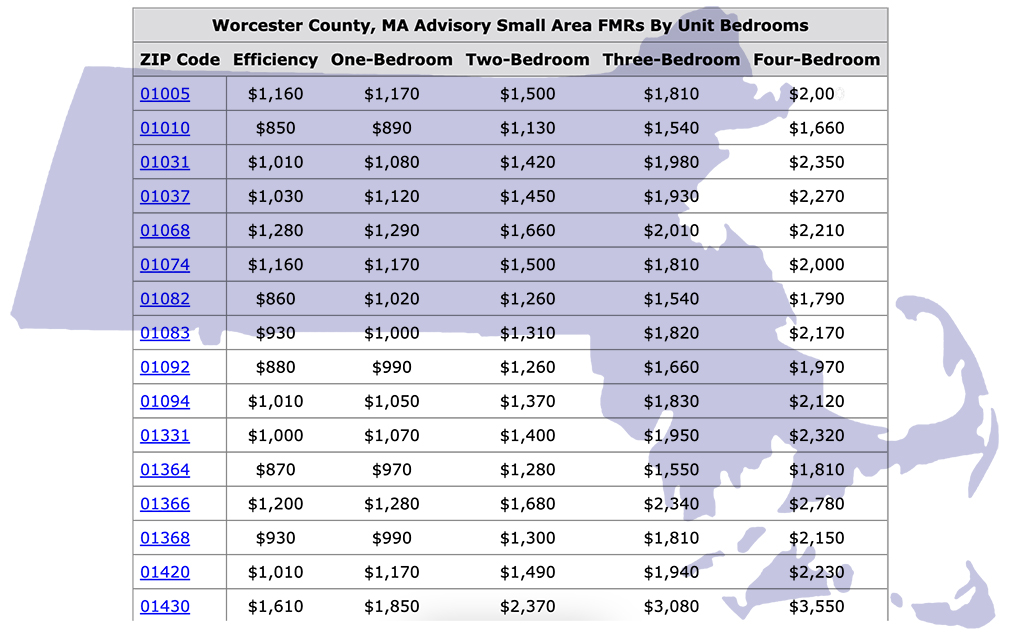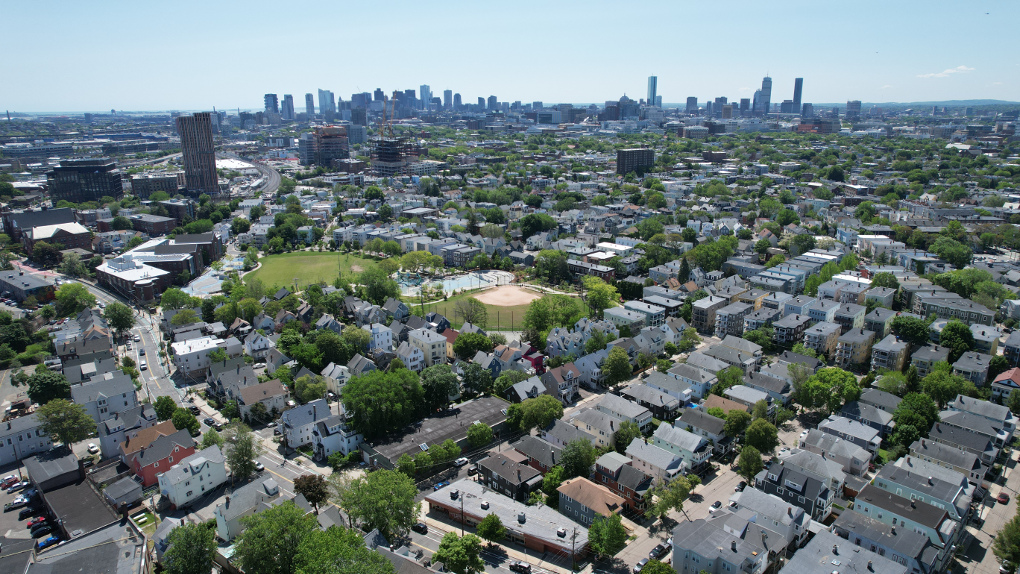HUD Small Area Fair Market Rents Now Represent 45% of Participants
. Posted in News - 2 Comments
By Kimberly Rau, MassLandlords, Inc.
The Department of Housing and Urban Development (HUD) announced that 41 new metropolitan areas across the country will be required to use small area fair market rents (SAFMRs) when calculating the maximum rent that housing choice vouchers (Section 8) will cover.

Though Massachusetts is not obligated to use Small Area Fair Market Rents in any of their metropolitan areas, HUD does provide SAFMR information for all areas. These are some of the ZIP codes in Worcester County, and their associated SAFMRs. [Lic: CC by SA MassLandlords Inc., chart from HUD.]
What Are Small Area Fair Market Rents?
Small area fair market rents (SAFMRs) trace back to the year 2000, when HUD determined that fair market rents that were calculated based on metro region averages were not effective in increasing availability in what they call “higher opportunity areas.”
In other words, the calculated rent amount that would allow someone with a housing choice voucher to live in a particular city would not allow them to live in good neighborhoods or suburbs. These areas are what are known as higher opportunity areas, neighborhoods that, according to HUD, “often have attributes that, based on recent research, seem to have a positive effect on the economic mobility of residents.”
HUD increased fair market rents to match median metro rents, but that didn’t solve the problem of people essentially being forced to live in high-poverty areas. In 2011, HUD began testing the concept of SAFMRs, calculating rent caps based on zip code instead of median metro rents. The testing was concluded by the end of 2016. HUD stated that 24 metro areas would be required to start using SAFMR calculations by Jan. 1, 2018. Shortly after the presidential administration turned over in 2017, HUD attempted to delay the roll-out, but lost a lawsuit seeking to overturn the delay for most of those 24 areas.

The cost to rent in one of these Somerville homes could be vastly different than the cost to rent a place in an outlying area. We wondered why Boston’s metropolitan area had not been placed under an SAFMR mandate, but HUD has a very specific formula for calculating which areas are compelled to follow SAFMR calculations. CC BY-SA MassLandlords, Paul Mong
Does the New HUD SAFMR Mandate Affect Massachusetts?
HUD may require certain metropolitan areas to utilize SAFMRs, but it also allows any housing authority to voluntarily adopt SAFMRs for its area. Such is the case in Massachusetts.
As of publication, there are no cities or towns in the state that are mandated by HUD to use SAFMRs. However, the Boston Housing Authority (BHA) announced in 2019 that it would be applying SAFMR calculations within the greater Boston area. All 236 zip codes in BHA’s housing area were affected by the change, allowing renters in those districts to have greater housing access.
Then, in November 2023, the Executive Office of Housing and Livable Communities (EOHLC) announced that it would be utilizing SAFMRs to calculate its payment standards statewide for the Massachusetts Rental Voucher Program (MRVP), also known as mobile vouchers. For most communities in Massachusetts, the applicable payment standard will be equal to 110% of that area’s SAFMR. Some exceptions exist. For example, the press release states that Lynn will have a payment standard equal to 100% of the area’s fair market rent for all its zip codes. Throughout Nantucket and Martha’s Vineyard, the payment standard will equal 110% of the area’s fair market rent. The changes are projected to begin on March 1, 2024.
If your rental properties are in one of the zip codes covered by the Boston Housing Authority, or you have a tenant with mobile vouchers, you can use HUD’s website to determine what your small area fair market rent would be for your units and apply that information accordingly. This data is updated annually. You can also find general fair market rent information through HUD’s website. It will tell you what the maximum rent is that you can charge and still participate in federal or state housing voucher programs.
How Does HUD Determine What Areas Must Utilize SAFMRs?
We wondered why Massachusetts has never been required to use SAFMRs when calculating Section 8 and other housing assistance rents. We reached out to HUD and learned that there are specific metrics they use to regulate districts across the country.
Representatives from HUD sent us a copy of the Small Area Fair Market Rent 2016 Final Rule. The rule provides an overview of the concept as well as the criteria for being required to use SAFMRs.
First, there must be at least 2,500 Section 8 units in the region under consideration.
Next, 20% or more of "standard quality rental stock" units must exist in zip codes where the SAFMR would exceed 110% of the area’s standard fair market rent (FMR). In other words, they are looking for big disparities.
Finally, HUD calculates the percentage of voucher holders living in low-income areas, relative to all renters living in that metropolitan area. If that calculation exceeds a threshold of 1.55, the area would meet the criteria for a SAFMR mandate. (The criteria for determining what makes an area “low income” has its own set of calculations, outlined in the HUD final rule document.)
If Massachusetts has not been ordered to utilize small area fair market rents, and is instead allowed to voluntarily opt in, it is because the state’s metropolitan areas do not fit HUD’s criteria for the mandate. We have not attempted to determine which criterion exempts us.
Conclusion
Everyone deserves access to safe housing. Allowing people to live in areas where their children will receive better educational opportunities and have access to more resources is one way to help break the generational cycle of poverty.
Remember, it is illegal in Massachusetts to deny someone a rental because they receive Section 8 or other forms of housing assistance. And while some landlords are averse to the idea of welcoming tenants who have housing vouchers, there are a lot of upsides to having a renter with subsidized housing vouchers in your unit. If nothing else, you’re guaranteed the government's share of rent will be paid. (Government shutdowns delay but do not cancel rent.)
Massachusetts may not be required to participate in SAFMR calculations, but it still has highly segregated housing patterns. Despite serving a great need, there’s a lot that our public housing administrators and agencies could be doing better (see our ongoing lawsuit against the Executive Office of Housing and Livable Communities, formerly DHCD). We are glad that at least one housing authority in the state has taken the initiative to utilize SAFMRs for its coverage area and that the state is following suit for MRVP.





Worcester housing authority is not using zip code SAFMR payment standards a 2 br with no utilities is 1440 with utilities 1640. it’s absolutely disgusting. many people are trying to port into other cities for a hope at having a better living. I have searched for an apt 2br for over a yr and have only found 1 for 1440 and it was horrid. wha does not care nor do they offer help.
Worcester housing authority is not using zip code SAFMR payment standards a 2 br with no utilities is 1440 with utilities 1640. it’s absolutely disgusting. many people are trying to port into other cities for a hope at having a better living. I have searched for an apt 2br for over a yr and have only found 1 for 1440 and it was horrid. wha does not care nor do they offer help. It does not even pay enough for subsidized housing offers